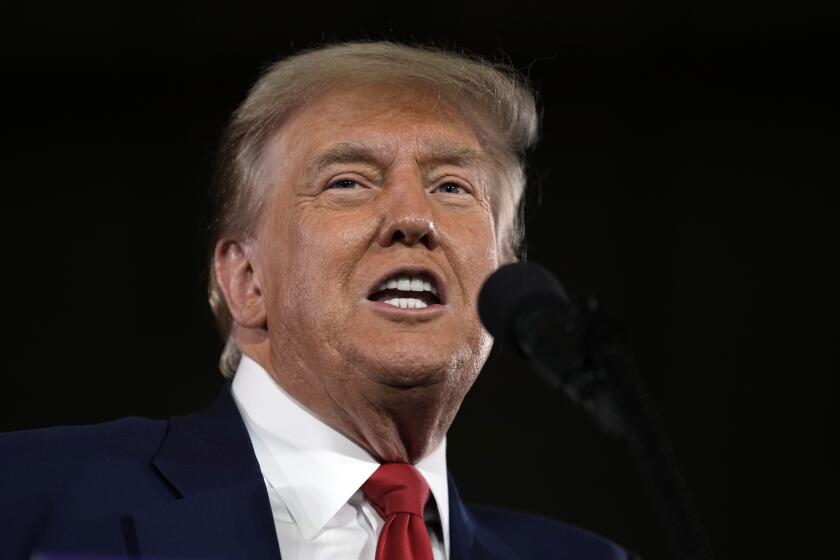3 Companies to Build Huge Border Factory
One of the biggest factories on the California-Mexico border, a $250-million glass plant employing 2,500 to 5,000, is to be announced by a U.S.-South Korean-Japanese venture, according to Mexican government officials here.
Word of the plant emerged at an international conference addressing the myriad problems arising from just such ventures along the booming U.S.-Mexican border.
The factory will be built by a partnership of South Korean electronics giant Samsung, U.S.-based Corning Glass and Asahi Optical of Japan, said Jaime Alatorre, president of the Mexican Investment Board, a government agency charged with attracting and facilitating foreign investment.
The factory is to be situated in either Mexicali or Tijuana and will make glass for computer and television monitors and other specialty products such as lasers and big-screen TV projection lenses.
Rumors about the plant have been circulating in Baja California in recent weeks and were confirmed by Alatorre. Corning declined to comment, and further details weren’t available.
Its customers are expected to be the growing roster of high-technology companies rushing to Mexico to take advantage of low-cost labor and to meet North American Free Trade Agreement content guidelines.
Word of the plant filtered out at a U.S.-Mexico conference on the mounting problems associated with the fast-growing border economy: increased pollution, scarce housing, traffic congestion and energy shortages.
The problems are serious enough to have attracted U.S. Commerce Secretary Mickey Kantor, his Mexican counterpart, Herminio Blanco, and 500 other government and business people to the three-day conference.
The cheaper peso and NAFTA requirements that manufacturers use components produced within the U.S.-Mexico-Canada trade zone have caused a headlong rush of foreign companies to Mexico over the last few years. Alatorre said foreign investment in Mexico through June is running 55% ahead of last year, which was the second-highest year on record.
Employment in Mexico’s maquiladoras is up at more than 750,000 and is increasing in some border regions by an annual rate of 20%, officials said. Kantor told attendees that U.S. exports, while slowed by the 1994 peso devaluation, are bouncing back and set an all-time monthly record in May at $4.7 billion.
But the prosperity has stretched border infrastructure to the limit and threatens NAFTA’s gains, Kantor said. Federal, state and local officials who spoke Monday recited a litany of woes focusing on pollution, scarce drinking water, overloaded roads and bridges and unaffordable worker housing; the fallout from the influx of foreign companies; and the migration of tens of thousands of Mexicans from the interior searching for work and a better life.
Oscar Luebbert, mayor of Reynosa in Mexico’s Tamaulipas state, said in an interview that NAFTA has brought his city a new Fujitsu factory and staggering 30% annual growth in jobs since 1994. But only 30% of his city’s streets are paved and only 70% have drainage. Ten percent of his citizens are without power and water because growth is so fast.
“NAFTA brought foreign investment, but we need help so that it doesn’t translate into social problems,” Luebbert said.
Mixed blessings are also evident on the U.S. side in El Paso, across the border from Ciudad Juarez, which, like Tijuana, is experiencing a boom in maquiladoras. The high volume in truck traffic has overloaded the U.S. city’s three bridges.
Responding to media reports that infrastructure funds have been too slow in coming from the North American Development Bank, the financing arm set up by NAFTA to address mainly environmental problems along the border, Kantor noted that waste-water projects take years to develop and that NADBank has been in existence only 16 months.
Water is another serious problem. The four-year drought in north-central Mexico has caused aquifers to fall to dangerously low levels, a condition made worse by increased industrial demand for water, said NADBank Chief Executive Alfredo Phillips Olmedo.
But solving environmental problems alone will cost an estimated $8 billion over the next 10 years, more than the governments have to spend, so both are looking for money from the private sector.
There has been some success with that approach in housing: General Motors’ auto parts operation in Mexico signed a deal in June with Infonavit, Mexico’s federal housing agency, to help provide up to 6,000 subsidized mortgage loans for maquiladora workers living in substandard housing.
“We need 300,000 housing units along the border cities alone over the next five years. It’s in the best interests of the maquiladoras to have them available because if not, the turnover of their employees is too high,” said Antonio Gonzalez-Karg, Infonavit’s general coordinator.
Energy shortages are being addressed by the privatization of parts of Mexico’s power-delivery business. U.S. and other foreign companies that see big profit potential are bidding on the rights to deliver natural gas and build power plants in several border cities.
But funding public works such as waste-water plants, freeways and bridges is a more difficult issue. The projects involve lengthy planning and are difficult to finance under any circumstances.
The first four NADBank-funded projects--waste-water and purification projects in Brawley, Calif., and Naco, Nogales, and Matamoros, Mexico--are to receive a total of $45 million in funds this fall, said Victor Miramontes, NADBank’s deputy managing director in San Antonio.
More to Read
Start your day right
Sign up for Essential California for news, features and recommendations from the L.A. Times and beyond in your inbox six days a week.
You may occasionally receive promotional content from the Los Angeles Times.






